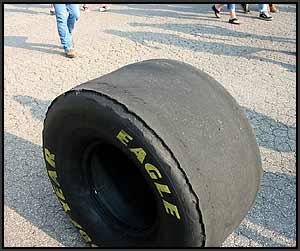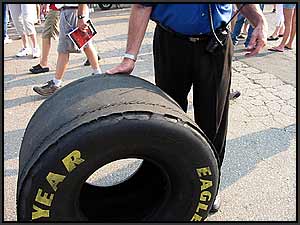|

By
Darr Hawthorne and Jeff Burk
Photos by Darr Hawthorne
9/9/04
 This
NHRA season has been one of extreme highs
and lows. The fiftieth U.S. Nationals being
the high and the death of Top Fuel driver
Darrell Russell being the low. This
NHRA season has been one of extreme highs
and lows. The fiftieth U.S. Nationals being
the high and the death of Top Fuel driver
Darrell Russell being the low.
The tragic death of Russell
is apparently directly attributable to the
failure of the Goodyear tires that by NHRA
rules must be used both front and rear on NHRA
Top Fuel and Fuel Funny Cars. The immediate
result from the June accident was the implementing
of a series of new rules for Top Fuel: the
rear-wing angle was changed to decrease downforce;
additional protection was allowed around the
cockpit to protect from flying objects and
the minimum weight was increased to compensate;
the allowable nitro percentage was reduced
to 85 from 90 percent. The changes were made
to keep the Top Fuel and Funny Cars at speeds
under 325 mph which, it was hoped, would end
or at least mitigate the tire failure.
After talking to many crew chiefs and drivers,
the only conclusion that any reasonable person
can come to is that all of the rules—with
the exception of the cockpit armor—are
abject failures. They have accomplished almost
nothing in the way of slowing the cars down
or stopping tires from chunking.
Top Fuel and Funny Cars at Indy both during
the race and in testing came very close to
the speeds and elapsed times they had been
running prior to the rule changes.
The startling fact is that the new Goodyear
tire, which was supposed to fix the tire chunking
problem that lead to Darrell Russell’s
death and to many high speed crashes over the
past decade, is, according to crew chiefs and
owners, possibly the worst tire they have had
to date as far as tire failure goes. The fact
is that every time a Top Fuel or Funny Car
driver makes a lap at an NHRA or IHRA race
the chances of a catastrophic tire failure
at speeds over 300 mph is not just a remote
possibility but a very real one.
To our knowledge, no one outside
of the management of NHRA, Goodyear, and perhaps
PRO (Professional Racers Association) have
seen any detailed, official report on the sequence
of events that led to Russell’s crash
and subsequent death. What is public knowledge
is that the crash was set in motion by a left
rear slick coming apart just past the lights,
which in turn damaged the rear wing strut causing
failure. For
a number of seasons nitro cars have been living
with the “chunking” of the Goodyear
slicks on both top fuel cars and to a lesser
extent in funny car. The solution for
the problem has always been to bring out a
new and improved version of the slicks, but
inevitably as crew chiefs mastered the new
combination they were able to apply more power,
more wing, more clutch and the tires came apart,
again. In 2004 alone both Bruce Litton and
Darrell Russell had crashes at over 300 mph
caused by tire failure.

Ray Alley gets an up close view of the
chunked edges of the tire at Indy. |
Even after the introduction of the new Goodyear
D2300 there was tire chunking on some dragsters
at Denver, Sonoma, Memphis and Brainerd. At
the completion of U.S. Nationals qualifying,
estimates of 19 to 22 tires were chunked or
damaged. This failure included not just the
rear tires but also the front.
|